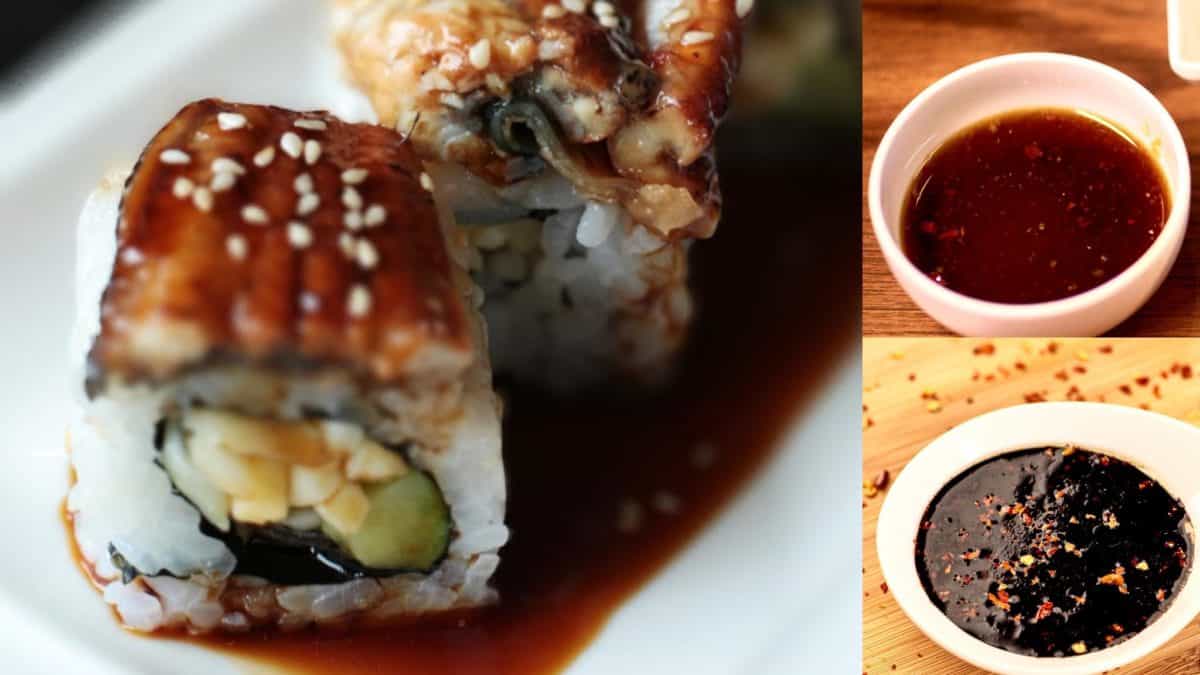Best Nitsume eel sauce substitutes for that nice glaze
If you don’t have eel sauce on hand and you need it for a recipe, you can use other sauces instead. You’ll want to look at the consistency AND the flavor.
Teriyaki and hoisin sauce are the best alternatives for eel sauce to get the right flavor and texture. you need a thick syrupy sauce that’s both sweet and salty to complement the eel, and you want to be able to glaze the fish with it.
Other sauces with similar ingredients include ponzu sauce, tempura sauce, and sukiyaki sauce so let’s look at when you can use each of these.

Variations like nitsume, unagi, and kabayaki can also work, according to a lot of people. But they’re actually all the same:
- Nitsume is the Japanese term for eel sauce
- Unagi is the term for the eel itself
- Kabayaki is a way of preparing the eel and then usually, eel sauce is used to dress the eel. It’s not correct to use the term “kabayaki sauce” as a sauce in itself
Eel sauce is a thick, sweet sauce used in Japanese cuisine. It is made from soy sauce, sugar, and mirin (a type of rice wine).
It’s made to be sweet to be able to get a nice luster on fish, but also salty to complement the sea flavors eel has.
If you want a closer replacement to store-bought eel sauce, then you can mix together sake, mirin, sugar, and soy sauce (full recipe here).
In this post we'll cover:
Eel sauce vs. ponzu
There are several sauces that are similar to eel sauce. One of these is ponzu sauce.
Like eel sauce, ponzu sauce is made with mirin. However, it also contains ingredients like rice vinegar (or use these substitutes!), katsuobushi flakes, and seaweed.
While the sauces don’t have the same taste, they’re used in similar applications. They can be used on sushi or as a condiment for fish and poultry.
Also check out these sweet and savory sushi sauces in our complete list
Eel sauce vs. teriyaki
Teriyaki is quite similar to eel sauce when considering its ingredients. Both use soy sauce, sugar, and water. Honey, ginger, and garlic powder are also often added to teriyaki to give it a unique flavor.
Eel sauce, on the other hand, has mirin to give it a distinctive taste.
While the 2 don’t taste exactly alike, they’re used in the same applications and make good substitutes for one another.
Eel sauce vs. hoisin
Hoisin sauce is similar to eel sauce in that it also has a soy sauce and sugar base.
However, it lacks mirin and has several other ingredients added, such as rice wine vinegar, sesame oil, garlic, and pepper. It can even have hot sauce added!
Although hoisin sauce can be used in the same applications eel sauce is used in, the taste is a lot more powerful.
Eel sauce vs. oyster sauce
While eel sauce isn’t actually made from eel, oyster sauce is made from oysters. It’s a combination of oyster’s natural juices mixed with sugar, salt, and sometimes cornstarch.
Oyster sauce is commonly used to flavor some types of sushi, but it can’t be used as a substitute for eel sauce in all recipes.
Nitsume vs. shoyu
Nitsume (eel sauce) isn’t the same as shoyu (soy sauce), although a large portion of the ingredients of nitsume is shoyu (around a third, to be exact). Nitsume has added mirin and sugar, which give it a very sweet taste and a much thicker consistency than salty shoyu alone.
Check out our new cookbook
Bitemybun's family recipes with complete meal planner and recipe guide.
Try it out for free with Kindle Unlimited:
Read for freeJoost Nusselder, the founder of Bite My Bun is a content marketer, dad and loves trying out new food with Japanese food at the heart of his passion, and together with his team he's been creating in-depth blog articles since 2016 to help loyal readers with recipes and cooking tips.

